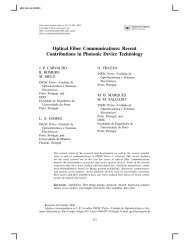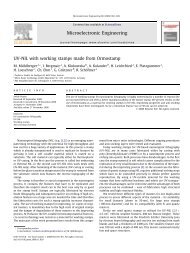Photosensitive Materials for Integrated Optic ... - ResearchGate
Photosensitive Materials for Integrated Optic ... - ResearchGate
Photosensitive Materials for Integrated Optic ... - ResearchGate
Create successful ePaper yourself
Turn your PDF publications into a flip-book with our unique Google optimized e-Paper software.
164 P. V. S. Marques et al.<br />
Figure 18. Microphotograph of the cross-section of buried channel waveguides fabricated on a<br />
silicon substrate.<br />
requires a UV-transparent fused silica mask substrate. It was found that the hybrid material<br />
does not need the addition of any kind of photoinitiator to polymerize when exposed at<br />
this radiation wavelength, contrary to what happens when the exposure is per<strong>for</strong>med<br />
using the 365-nm line of a mercury vapor lamp. The presence of a photoinitiator can<br />
be a drawback because of its potential contribution to the absorption loss of the final<br />
material at 1.55 µm. Good contact between the mask and the pre-baked hybrid film<br />
and optimized exposure parameters resulted in channels with perpendicular sidewalls,<br />
shown in Figure 18. Tolerances of film thickness of ∼ =0.2 µm, ridge waveguide width of<br />
∼=0.5 µm are typical. Surface roughness of planar films is usually below 5 nm; sidewalls<br />
roughness is below 50 nm, shown in Figure 19.<br />
The channel waveguides were characterized in terms of absorption loss (400 to<br />
1800 nm) using wide spectrum light coupled into multimode channel waveguides. The<br />
transmission absorption spectrum was measured with an optical spectrum analyzer and<br />
Figure 19. (a) Electron microscope top view of a device, (b) sidewall detail.





